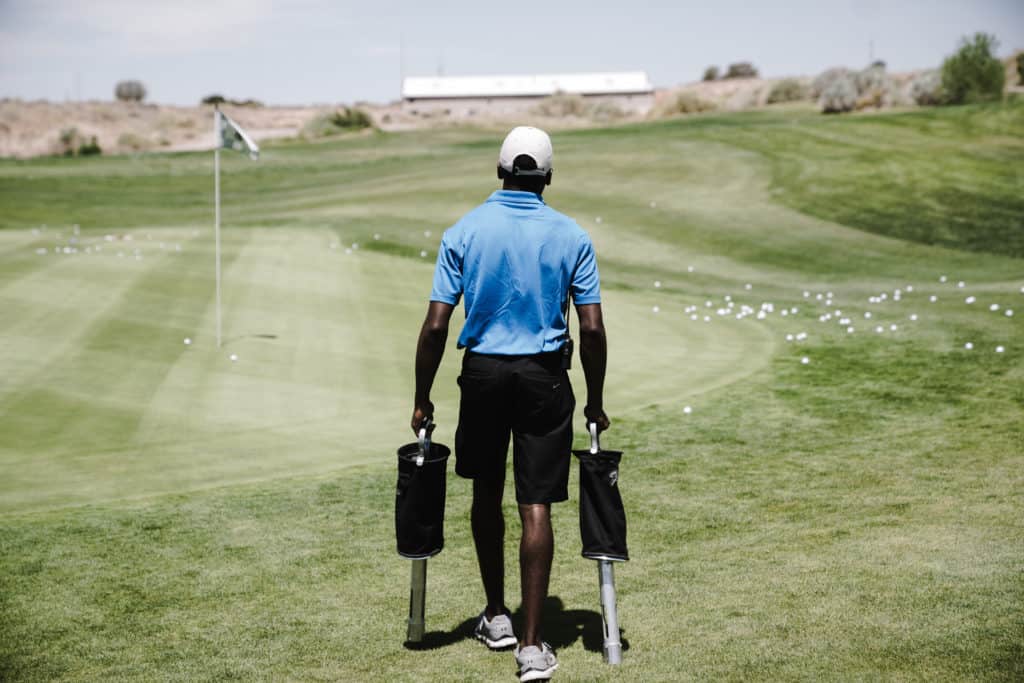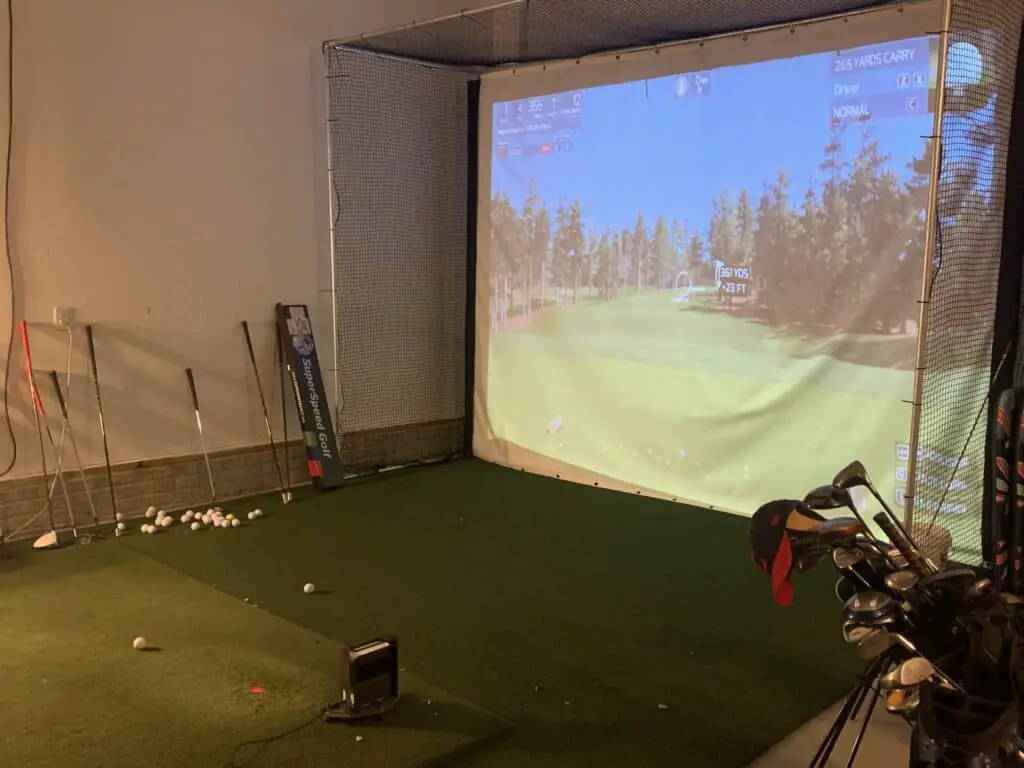You may have heard the stat before that around 60% of the shots in golf take place from 100 yards an in.
Or maybe you have been struggling to dial in your distances with your wedges.
The wedges are your scoring clubs. It is often more important to hit your wedge the same distance every time vs trying to hit your wedges as far as your can each time.
This is where the driver differs from the wedge. Total carry distance and how consistent you can be with that carry distance will help you get to the next level or hold you back!
Below, I will dive in and give you some guidelines on average how far you should hit your wedges based on your current swing speed with your driver.
I will also provide some tips to help you hit your wedge the distances necessary and to build a consistent swing to help you dial in those key distances.

How Far Should I Hit Wedges?
Here is a quick reference guide based on your driver swing speed. Please understand that factors such as loft, spin rate, launch angle and course conditions all impact the carry distance. However, this chart below will provide a general overview.
Resource: Do I need a sand wedge?
| Driver Swing Speed | 91 and Below | 91-101 | 102-112 | 113-123 |
| pw Distance | 110 | 121 | 131 | 136 |
| sw Distance | 90 | 100 | 110 | 120 |
| lw Distance | 70 | 80 | 90 | 105 |
Find where you fit in on this chart and then compare it to how far you hit your wedges. I fall into the 102-112 driver swing speed and hit my wedges in that ballpark of those distances.
The key, once again, is that if I hit my sand wedge 105 with a full swing to be able to hit the ball as close to 105 with a full swing frequently. If one time I hit it 110 and the next time 95 both with a full swing, I am going to struggle to turn my wedge shots into scoring opportunities.
Quick Guide on Wedges
A pitching wedge often has 44-48 degrees of loft and is your longest hitting wedge in the bag. The best golfers are able to take anywhere between a 70% and 100% swing to control distances and ball flight.
The next club is a sand wedge that often has between 54-56 degrees of loft and is the club between your pitching wedge and lob wedge. This club is versatile and for many will be used around 100 yards and in, all the way down to bunker shots and short chip shots.
Resource: Pitching wedge vs Sand wedge
The lob wedge has between 58 and 64 degrees of loft with most lob wedges being 60 degrees. This club is most often used on the shortest wedge shots, out of the sand and for many the higher loften chip shots needed around the green.
Resource: When to use a 60 degree wedge
One last option that many golfers choose is a gap wedge. This is a club that fits between the pitching wedge and the sand wedge. For example if the pitching wedge is 48 degrees and the sand wedge is 56, this 8 degree gap in the loft can create a gap that is difficult to fill. This is why the gap wedge has become more popular. Some golfers will choose to replace a long iron or hybrid for a 4th wedge in the bag.
If you are someone that struggles with controlling your distance and taking shots that are less than full swings, the gap wedge is a great option!
Resource: When to use a 52 degree wedge

Controlling the Distance on Your Wedges
The key to a great wedge game is to know how far you hit your wedges with a 70%, 80%, 90% and a 100% swing. I would highly recommend a golfer create a chart for each wedge in the bag that might look like the chart below:
| Club | Carry Distance (100%) | 90% | 80% | 70% |
| PW Club | 118 | 110 | 102 | 94 |
| SW Club | 105 | 97 | 91 | 84 |
| LW Club | 90 | 82 | 74 | 66 |
When a golfer is able to create a chart, they have multiple options with difference scenarios. Let’s look at some scenarios.
Scenario 1: An 83 yard shot
Let’s look at the options with an 83 yard shot left into a par 5. Looking at the chart the golfer has some options: hit the 90% lob wedge or the 70% sand wedge. The golfer might consider the pin placement, the location of bunkers and what the wind is going. If the pin is in the back, the golfer might go with the 70% lower flying sand wedge vs the 90% higher flying lob wedge. This will allow the golfer a better chance of flighting the ball back to the pin on the back of the green.
Scenario 2: A 92 yard shot
The golfer in this scenario has several options once again. The golfer can try to muscle the 100% lob wedge and hope for some release, hit the 80% sand wedge or something slightly less than the 70% pitching wedge. Once again the golfer should consider all of the same factors with the goal of leaving around a 10-15 foot putt and eliminating the big number. If the pin is on the front side of the green right behind a bunker or water hazard, trying to muscle in the 100% lob wedge is not advised. Instead the golfer should consider the 80% sand wedge and ensure the ball gets at least to the pin and might actually pick a yardage slightly more and refer to their chart they have created.

Other Factors on Carry Distance: Ball Position
The best golfers are able to hit multiple shots with each wedge. Not only from a percentage of the total swing, but also from the height of the shot. For example, by moving the ball back in your stance, you might hit the ball a bit lower, but maybe a bit further as well from reducing the loft of the club. Or if the golfer wants to hit the ball higher in hopes of the ball landing softly, they may move the ball forward.
Experimenting with different length swings and different ball positions, the golfer can create many options for their game with the hopes of maximizing the opportunities in the scoring range (anything inside of 125 yards for most golfers).
Resource: What wedges do I need?
Creating A Clock System
Many golfers with their 70%, 80% and 90% shots will use a clock to create a visual of where they need to take their front arm to. If the ball is sitting at 6:00, moving back and away they may measure their swing and the carry distance with a 7:00, 8:00, 9:00, 10:00 and an 11:00 length swing. This is another way to create the chart. Some like the specifics of the feel of where the arm goes to, or try to swing using the percentage system.
How to Create A Chart
The more scientific and data that can be used the great advantage the golfer has. Utlizing some great technology tools on the market will set the golfer apart and provide a key advntage over those that do not use some of these new tech toos.
There are two options. First, use a launch monitor to map out each wedge in the bag a the different swing lengths or percentages. Second, use the old fashion way of getting the ball you play with on the course and an open driving range where you can hit to specific distances and take an average.

Option 1: Use A Launch Monitor
I would highly recommend a launch monitor. These portable devices can be used at the driving range, golf course or set up in your home net or golf simulator. These devices are game changers not only on being able to map your bag and know your distances, but they also provide quality feedback after on every shot and provide the following information:
- Carry Distance
- Spin Rate
- Launch Angle
- Spin Axis
- Total Distance
- Ball Speed
This information will help you map your bag and knowing the exact distances of your wedges at different length swings. In addition, the launch monitors can be used to decide on which clubs are best for your game, develop a stock shot and much more. I love using my SkyTrak 365 days a year in my golf simulator setup.
The process for mapping your wedges can looking something like this:
- Hit 5 shots with each wedge in your bag.
- Log the carry distance and total distance for each shot.
- Eliminate any outlier numbers (poor hits or low spin rates).
- Hit shots at 90%, 80% and 70% using the same total of 5 shots at each distance.
If you visit any PGA Tour even you will see plenty of golfers utilizing their launch monitors. Why most can’t afford a Trackman, there are some very affordable options in the 500-2000 dollar range. I own the SkyTrak and think the world of it.
Here are the top 3 options to check out:
Option 2: Use a Driving Range or Open Field
If you can’t afford a launch monitor at this time, here is another option.
- Find an open driving range or open field
- Take 10 balls of the type of golf ball you play
- Pick a target and either walk it off or use a rangefinder.
- Hit 10 shots with each wedge in your bag and take an average.
- Your rangefinder can help you get a specific distance.
- Repeat for each length swing you want to create a chart with
Resource: SkyTrack Launch Monitor: The Ultimate Game Improvement Tool
Take Action – What You Can Do Today to Get Better
What does this mean for you? I believe in the following recipe to get better:
1 – Improve your motion in the golf swing by identifying a golf instructor. Here are some options:
Here is a list of golf instructors that we have reviewed:
2 – Train to swing faster and improve your swing speed. Here are some options:
Looking to gain more Speed and Distance in your swing. Two Options:
3 – Understand course strategy and work to break through your next barrier. Here is a series on breaking through:
We have provided guides on how to break 100, 90, 80 and 70. Check out more below, if interested.
4 – Practice Frequently
Did you know that I build a golf simulator in my garage and have played over 500 rounds of golf on my SkyTrak system? It has been a game changer and one worth checking out. Here are some of my other posts on golf simulators frequently asked questions:
- Is a Golf Simulator Worth It?
- How to Build a Golf Simulator?
- What is the Best Golf Simulator?
- Golf Simulator Accessories?
- How to Build a Golf Simulator for under $7000
- Top 11 Reasons to Buy a SkyTrak
- How to Build a Golf Simulator for Under $1000
- Why Build A Golf Simulator?
- What Space is Needed?
- Can A Golf Simulator Improve My Game?
- How Much Does A Golf Simulator Cost?
- Don’t Forget to Check out our 15 best golf swings of all time.
